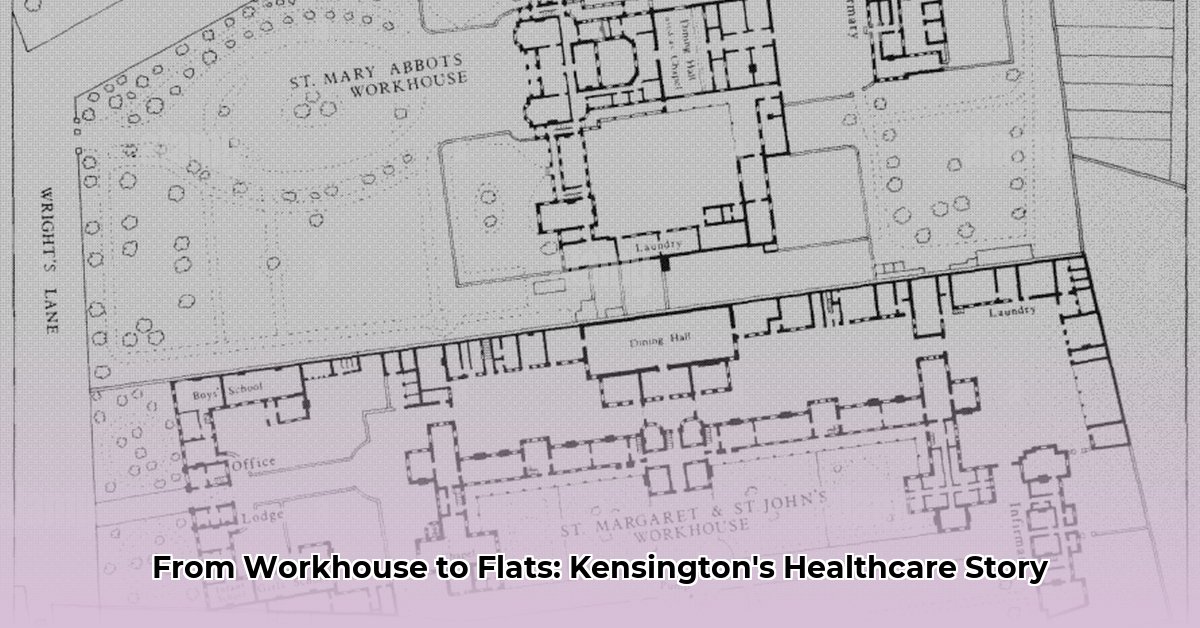From Workhouse to Hospital: The Early Years
St. Mary Abbots Hospital, a name synonymous with Kensington healthcare for over a century, began its life not amidst sterile wards and modern equipment, but within the austere walls of a workhouse. In 1847, the Kensington workhouse, a product of the era’s Poor Law system, opened its doors on an eight-acre plot known as Broomfield, just north of Lexham Gardens on Marloes Road. This marked the beginning of a long and complex journey, mirroring the evolution of social welfare and medical care in London. Just a few years later, in 1850, the neighboring parishes of St. Margaret and St. John, Westminster, established their own workhouse on adjacent land. The proximity of these two institutions likely influenced their eventual merging and transformation. In 1871, a crucial turning point arrived: an infirmary was established within the Kensington workhouse, signaling a shift from simply providing shelter to offering actual medical care. This infirmary, though modest in its early form, would become the foundation of St. Mary Abbots Hospital. It probably offered basic medical treatments and palliative care, reflecting the limited resources and medical understanding of the Victorian era.
Growth and Transformation: A 20th-Century Institution
The turn of the 20th century brought significant changes. In 1912, the Kensington Infirmary, as it was then known, formally separated from the workhouse system, reflecting a changing social perspective on poverty and healthcare. The official designation as St. Mary Abbots Hospital in 1923 solidified its identity as a dedicated medical institution. The hospital continued to evolve, expanding its services and adapting to the community’s needs. The construction of a pathology lab in 1932 significantly enhanced diagnostic capabilities, benefiting not only the hospital but also other healthcare facilities in the area. The growing demand suggests that St. Mary Abbotts was becoming an increasingly vital part of the local healthcare network. Under the management of the London County Council from 1930, the hospital likely experienced further modernization and administrative changes. By 1955, it proudly stood as an acute general hospital, offering a wide range of services. The records reveal that St. Mary Abbots provided maternity care, general surgery, and treatment for infectious diseases like tuberculosis, along with growing provisions for mental health.
Specialization and Challenges: The Later Years
The mid-20th century saw St. Mary Abbots become a hub for specialized care. A significant development in 1953 was the relocation of the Metropolitan Ear, Nose, and Throat Hospital to St. Mary Abbots. This merger suggests a growing emphasis on specialized care within the NHS. The hospital also developed a focus on geriatric and psychiatric services. While these specializations addressed crucial healthcare needs, they may have also limited the hospital’s ability to compete with larger, more comprehensive facilities.
Closure and Legacy: A Kensington Story Ends
The year 1944 brought a devastating blow. A V-1 flying bomb struck the hospital, causing significant damage and tragic loss of life. Five nurses, six children, and seven adult patients perished in the attack. The damaged sections, including the original 1871 infirmary and part of the 1847 Stone Hall, were forced to close. This event, though undoubtedly a setback, highlighted the hospital’s resilience. Despite the damage, St. Mary Abbots continued to operate in its remaining capacity, serving the community through difficult times. The bomb damage, however, likely contributed to the long-term challenges the hospital faced.
Despite its long history of service, St. Mary Abbots Hospital closed its doors in 1992. While the exact reasons remain a subject of ongoing historical inquiry, several factors likely contributed. The opening of the modern Chelsea and Westminster Hospital on Fulham Road may have led to the consolidation of services in the area. Financial pressures, perhaps exacerbated by the costs of maintaining an older building, and the evolving needs of the community likely played a role. The closure marked the end of an era, leaving a void in the local healthcare landscape. Today, Kensington Green, a luxury housing development, occupies the site. Yet, echoes of the past remain. The original gates still stand, and perhaps portions of the workhouse structures are incorporated into the new buildings, offering silent testimony to the site’s history. Stone Hall, remarkably, survived the bombing and remains as a poignant reminder of the hospital’s legacy.
Timeline: St. Mary Abbots Through the Years
| Date | Milestone |
|---|---|
| 1847 | Kensington workhouse established |
| 1850 | Westminster workhouse established |
| 1871 | Infirmary opens within Kensington workhouse |
| 1912 | Kensington Infirmary separates from workhouse system |
| 1923 | Officially named St. Mary Abbots Hospital |
| 1930 | London County Council assumes control |
| 1932 | Pathology lab established |
| 1944 | V-1 bomb hits hospital; significant damage |
| 1948 | Integration into the National Health Service (NHS) |
| 1953 | Metropolitan Ear, Nose, and Throat Hospital relocates to St. Mary Abbots |
| 1955 | Becomes an acute general hospital |
| 1992 | Hospital closes |
| Post-1992 | Redevelopment into Kensington Green |
Further Exploration: Uncovering the Stories
The story of St. Mary Abbots Hospital invites further exploration. Researchers and those interested in local history can delve deeper into the hospital’s records, likely held at The National Archives. Exploring archival materials, local historical societies, and personal accounts could reveal more about the lives touched by this institution. The hospital’s journey reflects the broader narratives of social change, medical progress, and the evolving needs of a community. While some questions may remain unanswered, the story of St. Mary Abbots continues to resonate, reminding us of the important role such institutions play in the fabric of our cities.
- Wind Power Energy Advantages: Clean, Domestic And Cost-Effective Power - November 12, 2025
- Wind Turbine Pieces: Examining The Industrys Future Growth - November 9, 2025
- Wind Turbine Installation: Building the Future of Energy - November 7, 2025
















